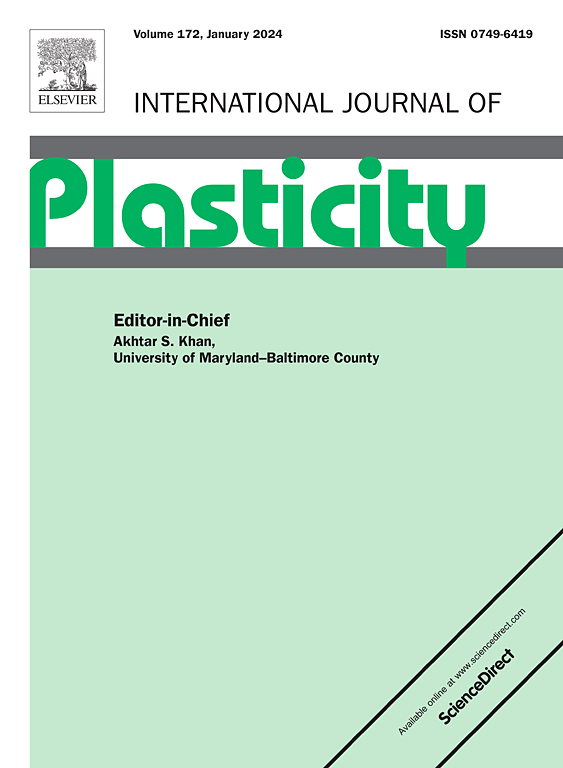定向凝固发展高强高塑性高熵合金:一种多方面强化方法
IF 12.8
1区 材料科学
Q1 ENGINEERING, MECHANICAL
引用次数: 0
摘要
高强度、高延展性合金是先进工程应用的关键;然而,实现这两种特性的平衡组合仍然是一个重大挑战。在这里,我们通过组织设计和工艺优化成功地开发了一种具有优异力学性能的合金。采用定向凝固法制备了Al1.25CoCrFeNi2.8Mo0.2双相高熵合金(HEA),该合金具有独特的显微组织,显著提高了强度和塑性。该合金的屈服强度为505 MPa,极限抗拉强度为1166 MPa,均匀伸长率为19%,具有优异的力学性能。与常规铸态HEA相比,伸长率提高了46%,抗拉强度提高了5%。增强的性能归因于固溶强化、相界面强化和沉淀硬化机制的协同结合。详细的显微组织分析表明,面心立方相中的分层层错网络有利于强化加工硬化。同时,b2有序纳米颗粒作为位错运动的有效障碍,导致强度显著提高。此外,单向片层组织通过抑制裂纹扩展来提高断裂韧性。这项研究强调了将先进的冶金设计与加工技术相结合以生产高强度、延展性金属材料的潜力。本文章由计算机程序翻译,如有差异,请以英文原文为准。


Development of high-strength and high-ductility high-entropy alloys via directional solidification: A multifaceted strengthening approach
High-strength and high-ductility alloys are crucial for advanced engineering applications; however, achieving a balanced combination of these two properties remains a significant challenge. Here, we successfully developed an alloy with exceptional mechanical properties through microstructural design and processing optimization. By employing directional solidification, we fabricated an Al1.25CoCrFeNi2.8Mo0.2 dual-phase high-entropy alloy (HEA) that exhibits a distinctive microstructure, which significantly enhances both strength and ductility. The alloy demonstrates superior mechanical performance, with a yield strength of 505 MPa, ultimate tensile strength of 1166 MPa, and uniform elongation of 19 %. Compared with the conventional as-cast HEA, the elongation is increased by 46 %, and the tensile strength is increased by 5 %. The enhanced properties are attributed to a synergistic combination of solid solution strengthening, phase interface strengthening, and precipitation hardening mechanisms. Detailed microstructural analysis reveals that hierarchical stacking fault networks in the face-centered cubic phase facilitate enhanced work hardening. Concurrently, B2-ordered nanoparticles acted as potent obstacles to dislocation motion, resulting in a significant enhancement of the strength. Additionally, the unidirectional lamellar microstructure improves fracture toughness by inhibiting crack propagation. This study underscores the potential of combining advanced metallurgical design with processing techniques to produce high-strength, ductile metallic materials.
求助全文
通过发布文献求助,成功后即可免费获取论文全文。
去求助
来源期刊

International Journal of Plasticity
工程技术-材料科学:综合
CiteScore
15.30
自引率
26.50%
发文量
256
审稿时长
46 days
期刊介绍:
International Journal of Plasticity aims to present original research encompassing all facets of plastic deformation, damage, and fracture behavior in both isotropic and anisotropic solids. This includes exploring the thermodynamics of plasticity and fracture, continuum theory, and macroscopic as well as microscopic phenomena.
Topics of interest span the plastic behavior of single crystals and polycrystalline metals, ceramics, rocks, soils, composites, nanocrystalline and microelectronics materials, shape memory alloys, ferroelectric ceramics, thin films, and polymers. Additionally, the journal covers plasticity aspects of failure and fracture mechanics. Contributions involving significant experimental, numerical, or theoretical advancements that enhance the understanding of the plastic behavior of solids are particularly valued. Papers addressing the modeling of finite nonlinear elastic deformation, bearing similarities to the modeling of plastic deformation, are also welcomed.
 求助内容:
求助内容: 应助结果提醒方式:
应助结果提醒方式:


